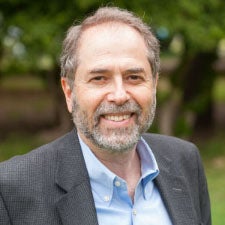|
Getting your Trinity Audio player ready…
|

Vincent James, a multitalented web designer who built the California Health Care Foundation’s website and developed its online communications strategy for 26 years while making noteworthy contributions in the photographic and musical arts, died on June 14 in Oakland. He was 59.
His wife, Melissa Lucas, said he died suddenly of natural causes.
In all his endeavors, James was an innovator who performed and created at a high level without formal training. He dropped out of high school to play drums in a band. He later earned a general education diploma but never attended college.
In addition to his professional achievements in online communications, James had a passion for photography. He became an accomplished photographer whose landscapes, skyscapes, and fogscapes awed social media followers around the world and garnered respect and admiration from a large community of fellow photographers.
Mounting cameras on earthbound tripods and launching drone cameras into the sky, he created an enormous catalog of visually arresting images, most captured in Northern California. His work drew a large audience; on Instagram, he had 110,000 followers, and each of his nearly 2,000 photos would routinely receive 2,000 to 5,000 likes.
The motif in James’s music and photography reflected a moody, existential angst he carried with him after experiencing hardships in his younger years. His father abandoned the family when Vincent was a youngster, and his mother lived much of her life with significant health problems that emerged when James was a young adult. To some, he seemed a brooding loner, but those who had the chance to know him experienced his kindness, gentleness, and generosity.
A Website for a New Foundation
James’s interest in digital technology began in 1993, while working for the New York City Parks Department. One day a computer arrived at his workplace, and with his flair for picking up new skills, he figured out how to operate it. He ended up teaching his coworkers how to use it.
He soon started designing and building websites. He was recruited by a Silicon Valley start-up to join in the tech boom, and in 1996 James relocated to the Bay Area. He worked for several tech start-ups that failed and pondered whether to return to New York before CHCF hired him in 1998, shortly after California established the foundation to focus on grantmaking to improve the health of state residents. At CHCF, he met Lucas. They were coworkers for 19 years.
“Vincent didn’t know anything about foundations or philanthropy or health care when he started,” said Sam Karp, the CHCF senior vice president who hired him. That didn’t matter to the highly confident James, who spearheaded the creation of CHCF’s website. “Vincent built the infrastructure that CHCF used to communicate its grantmaking, policy objectives, and the work of its grantees,” Karp said.
Until his death, James oversaw the development and evolution of the foundation’s digital strategy, including its cutting-edge website. As organizational objectives changed and web technologies, design, and user experience best practices evolved, James adapted the website.
CHCF pioneered ways for foundations to embrace and utilize the web, Karp said.
“Vincent had an artistic perspective about everything he did,” Karp said. “He was deeply moved by the arts and music. It influenced everything — his design, his rhythm, his sense of shape and construction, the lighting in his photography — everything.”
Another CHCF colleague, Maribeth Shannon, collaborated with James on a consumer information website comparing quality data from California hospitals. The ratings data were so complicated that James knew most people would have difficulty understanding them.
“Vincent thought long and hard about it, and given his interest in visual display and his understanding of what people could grasp, he came up with a really clear and concise way to present the information,” Shannon said. “CHCF became a model for how other states could do that kind of work. He was a true Renaissance man of many talents and many interests.”
After many years, the operation of the Cal Hospital Compare website was transferred from CHCF to a different organization in 2017, and the hospital ratings are still online and kept up to date, she said. The website has remained mostly unchanged from what James designed, Shannon said.
Born in the Bronx
James was born Vincent James Salzillo in the Bronx, New York, in 1964. His father, Neil Salzillo, was proprietor of a neighborhood candy store, and his mother, Katherine (Kitty) Lento Salzillo, managed a movie theater. Their marriage ended when Vincent was five years old, and his mother became a single parent. Because he often joined his mother at the theater while she was on the job, Vincent developed a strong interest in film and the visual arts and demonstrated an aptitude for all kinds of technologies.
James began dreaming about becoming a professional musician after he was given a drum kit by a family friend at age 13. He never took lessons or received formal musical training. He cultivated his musical skills on drums, guitar, and keyboards through practicing tirelessly, observing other musicians, and watching videos.
In 1990, Vincent married his first wife, Penny Blatt. During those years, he formed an acoustic rock band called Elizabeth Gone. The group was enjoying success in the New York area, including performing at the legendary CBGB club in Manhattan’s East Village. In the belief that ethnic names were not good stage names, he stopped using the surname Salzillo and started calling himself Vincent James, which he later formalized in court. When his marriage ended and Silicon Valley called, James decided to move to California.
He started writing and producing electronica music on his desktop computer at home, using his own drumbeats, keys, and samples in combination with recordings of guest guitarists on lead and ambient vocalists. His musical interests were broad, and James couldn’t be categorized as a specialist in any one genre of music. As a child of the 1970s, he was greatly influenced by classic rock, new wave, British invasion, and modern rock. “It took me a while to realize that his passion and discipline were fueled by his obsession with expressing himself,” Lucas said.
“Vincent’s enthusiasm was infectious, and he made the whole thing fun,” said Brian Mello, an Oakland guitarist and vocalist who began in 2016 playing in various groups led by James. “When we first started playing together, I feared it would be lackadaisical and something that would just happen in a garage and go no further. But he had gigs lined up quickly and found other musicians who were like-minded and roped them in. Neither of those things is easy, and it showed how much work he put into things.”
James’s visual arts impulses never stopped vying for his attention. At a band gig in 2008, a friend showed him a new compact digital camera, and James again abruptly switched gears. “He was in such a battle with himself, trying to live in both worlds,” Lucas said. “He always had one eye on the weather and what was happening with the fog and the clouds.”

Nature in the Frame
As James dove into photography, his unstoppable drive led him to travel in search of nature’s daily choreography of color, mood, action, and light. From 2009 through 2017, he and Lucas explored California as well as the Southwest, Yellowstone National Park, New England, Hawaii, Oregon, and Iceland — she honing her birding skills while he produced a stream of extraordinary images. His still photos looked as if they were moving.
James’s creative drive was unrelenting. On many days, instead of sleeping in, he jumped into his car at 4:30 AM to drive from his Oakland home to the Marin Headlands just in case that day’s sunrise might surpass the hundreds of stunning sunrises he had already captured.
James was admired by photographer colleagues for his achievements and the communal spirit he showed at scenic locations that could be hard to hike to — places that were sometimes cold, wet, and unpredictable. The results were potent.
“It is hard to overstate the power of his imagery,” wrote photographers Falu Bakrania, Subha Joshi, Michelle Liu, and Darcy Mead in a social media post on the Instagram page they moderate, West Coast Framerz. “His photographs of the Bay Area and beyond have gained widespread recognition for their brilliant use of light, color, and composition. More than this, they were full of stories and emotion.”
Dan Kurtzman and Jesse Cortes run an Instagram page that features landscape photos contributed by photographers from across the Bay Area. They said James inspired people to reach higher. “He mentored numerous photographers, generously sharing his insights to help others improve their craft,” they wrote. “For years he also served as a moderator for @wildbayarea, where he helped to showcase the work of both established and up-and-coming artists to whom he wanted to help give more exposure.”
Golden Sunlight
The day before his death, James posted a memorable image on Instagram. He was driving his car across the Bay Bridge toward San Francisco when he snapped a dramatic early-evening photo of Alcatraz. The island appeared to be both threatened by a massive dark cloud bank and backlit by the glowing aura of low, golden sunlight.
“kids, don’t ever do this [take photos while driving], but I was quite impressed how this iPhone pic came out as I was driving over the bay bridge about 30 minutes ago,” he wrote cheerfully.
Instagram followers responded, as usual, with words like “stunning,” “lovely,” “singular,” “brilliant,” “glorious,” “iconic,” “awesome,” and “like a painting.”
“In the 26 years I worked with Vincent, first as a colleague and friend, then as his supervisor, I was continually amazed by his drive to make everything he did match his idea of what it could be,” said Sally Mudd, CHCF’s director of engagement. “That came out in his work and his art. He was a true artist — never resting on his laurels, always striving to get to that next level of perfection. He was one-of-a-kind in every way.”
Vincent James and Melissa Lucas began exploring ethical nonmonogamy in 2017. They remained committed to one another as life partners and continued living in their shared home. James is survived by Lucas, his partner of 26 years, and Jane Earle, his girlfriend of five years.
He is also survived by his sister, Maryann Salzillo; her son, James Downey, and his partner, Jill McLaughlin, along with their children, John and Zach; his sister-in-law, Francie Salzillo, and her children, Ashley and Austin; his father-in-law, Frank Lucas; and his wife’s siblings and their families (Jennifer Lucas; Laura Nakamura and her husband, Greg Colley, and her children, Rachel Nakamura and Lucas Nakamura; and Kevin Lucas and his wife, Lucy Streett, and their children, Oliver, Harry, and Catherine).
James’s first marriage, to Penny Blatt, ended in divorce, but they remained friends. He was predeceased by his parents; his brother, Neil Salzillo; and his mother-in-law, Donna Lucas.
A memorial celebration is being planned for late summer.
Authors & Contributors













